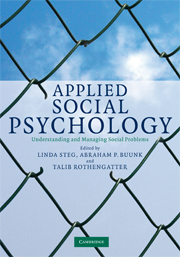Book contents
- Frontmatter
- Contents
- List of figures
- List of tables
- List of boxes
- List of contributors
- Acknowledgments
- 1 Introduction to applied social psychology
- 2 The USE of theory in applied social psychology
- 3 Applications of social psychology to increase the impact of behaviour-focused intervention
- 4 Research designs in applied social psychology
- 5 Social psychology and economic behaviour: heuristics and biases in decision making and judgement
- 6 Social psychology and immigration: relations between immigrants and host societies
- 7 Applying social psychology to the classroom
- 8 Social psychology and environmental problems
- 9 Gender issues in work and organizations
- 10 Social psychology of health and illness
- 11 Social psychology and mental health
- 12 Social psychology and modern organizations: balancing between innovativeness and comfort
- 13 Social psychology and the study of politics
- Index
- References
2 - The USE of theory in applied social psychology
- Frontmatter
- Contents
- List of figures
- List of tables
- List of boxes
- List of contributors
- Acknowledgments
- 1 Introduction to applied social psychology
- 2 The USE of theory in applied social psychology
- 3 Applications of social psychology to increase the impact of behaviour-focused intervention
- 4 Research designs in applied social psychology
- 5 Social psychology and economic behaviour: heuristics and biases in decision making and judgement
- 6 Social psychology and immigration: relations between immigrants and host societies
- 7 Applying social psychology to the classroom
- 8 Social psychology and environmental problems
- 9 Gender issues in work and organizations
- 10 Social psychology of health and illness
- 11 Social psychology and mental health
- 12 Social psychology and modern organizations: balancing between innovativeness and comfort
- 13 Social psychology and the study of politics
- Index
- References
Summary
Introduction
Jessica got to work on time today, but just barely. After driving down the freeway from the suburban community of Carlsbad to the city of San Diego at rush hour, she was personally aware of the congested roadways of this urban area. But unlike most of us who endure traffic delays, she gets to think about it all day at her job. Jessica works for the Metropolitan Transit System in San Diego, California. Her office oversees the bus, trolley and rail services throughout the city. Her job is to work out ways to decrease road congestion and increase the public's use of the public transport systems. The problem is fairly clear – too many people (including Jessica!) take private cars to work. The existing streets and roadways cannot accommodate the 1.2 million residents that make use of them, and, especially during morning and evening hours when people are commuting to and from work, traffic is a major problem.
Like all of the social problems discussed throughout this book, human behaviour is the cause. Consequently, solving the problem will require a change in behaviour. But changing human behaviour can be challenging, and our chances of success can be greatly increased by incorporating a social-psychological perspective. We can begin with some basic psychological questions: What motivates a person to drive, rather than take the bus?
- Type
- Chapter
- Information
- Applied Social PsychologyUnderstanding and Managing Social Problems, pp. 28 - 56Publisher: Cambridge University PressPrint publication year: 2008
References
- 4
- Cited by



